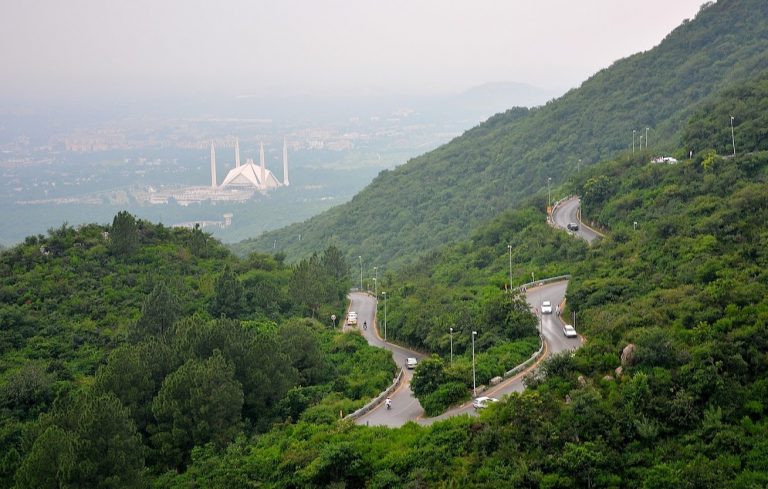The Margalla Hills are a hill range within the Margalla Hills National Park on the northern edge of Islamabad the Capital of Pakistan. Just south of Haripur District, Khyber Pakhtunkhwa. Furthermore they are part of the Himalayan foothills. The Margalla range has an area of 12,605 hectares. It is a range with many valleys as well as high mountains.
Moreover there are around 250 to 300 species of plants found on the Margalla Hills.
Historical View :
According to the research carried out by scientists and archaeologists of the project “Post-Earthquake Explorations of Human Remains in Margalla Hills”. The formation of the Margalla Hills dates to the Miocene epoch. The dominant limestone of the Margalla is mix with sandstone and occasional minor beds of shale. The archaeologists of the project have also found two human footprints over one million years old here, preserved in sandstone.
Wildlife of Margalla Hills :
Margalla Hills are unique in Pakistan, being rich in Sinohimalayan fauna. Some species (especially birds) of which are at the western extremity of their distribution. In addition it is an extention of the Islamabad wildlife sanctuary. Which includes the Shakar Parian Hills and the Rawal Lake. Moreover the park was setup to provide refugee to the Gray Goral, Barking deer and the Leopard. Protection to these animals have benefitted other unusual and interesting smaller animal as well. Margalla Hills Park provides an excellent opportunity for bird watching. A Cheer Pheasant hatchery was establish at Chak Jabri and Dhok Jewan to raise captive Cheer pheasants that have become extinct in the hills. These are then release in the wild.
Mammals:
Furthermore Mammals are here include Asiatic leopard, Wild boar, Golden Jackal, Rhesus Macaque, Leopard cat, Gray Goral sheep. Moreover Barking deer, Chinkara gazelle, Red fox, Pangolin, Porcupine, Yellow throated marten and Fruit bats.
Birds:
Moreover Birds are here include Himalayan Griffon vulture, Laggar falcon, Peregrine falcon, Kestrel, Indian sparrow hawk, Egyptian vulture, White cheeked bulbul. Also yellow vented bulbul, Paradise flycatcher, Black partridge, Cheer pheasant, Khalij pheasant. Furthermore Golden oriole, Spotted dove, Collared dove, Larks, Shrikes, Wheatears and buntings.
Reptiles:
Reptiles are include Russell’s viper, Indian cobra, Himalayan pit viper and Saw scaled viper.
Activities to do :
Bird watching :
The Margallas are an excellent place for bird watchers. Moreover the area is home to a large number of birds, including robins, sparrows, kites. Crows, larks, paradise flycatchers, black partridge, shrikes, pheasants, spotted doves, Egyptian vultures, falcons, hawks, eagles. Furthermore Himalayan griffon vulture, laggar falcon, peregrine falcon, kestrel. Indian sparrow hawk, white cheeked bulbul, yellow vented bulbul, paradise flycatcher, cheer pheasant, Khalij pheasant, golden oriole, spotted dove, collared dove, wheatears and buntings.
Islamabad Panoramic View :
The most visited hill stations Pir Sohawa and Daman-e-Koh provide the visitors with a panoramic view of Islamabad’s beautiful city. Visitors view Rawal lake, 7th Avenue, and Faisal Mosque from this spot.
Hang-Gliding and Paragliding :
Islamabad-based clubs provide facilities for Hang-Gliding and Paragliding.
Rock Climbing :
Rock climbing is getting popularity among ISB and Rawalpindi youth, but only a few climbers can climb at heights.
How to Reach Margalla Hills ?
While many people choose to hike up the numerous paths in the region. A well-paved road is available for cars, leading up to Monal Restaurant and Pir Sohawa. Moreover the road Pir Sohawa Road and the route starts off near Islamabad Zoo and the Japanese Children Park, at the base of the hills near Daman-e-Koh.
Margalla Hills Trails :
TRAIL-1
It begins behind the Sectors E-8 & E-9 and comprises of 3-interconnected sub-trails. Hiking started from small Mazar-complex in Kalinger village. The trail initially moves along the water-stream leading into mountains. It takes a considerable effort to find the path.
TRAIL-2
Among 6-officially marked trails, the Trail-2 that leads to Damn-e-Koh is shortest and has 2-distinct trailheads. 1st is situate at the narrow dirt-track astride the Marghazar-Zoo. Another trailhead is located at the start of Pir Sohawa Road.
TRAIL-3
It is the most visited hiking trail that is adequately maintained and well-marked. Trailhead is situated opposite to Sector F-6 on the Margalla Road, and parking-area is available. The foreigners frequently visit this trail due to several embassies in proximity.
The difficulty level for hiking on Trail-3 is moderate. The time required for hiking is 2 to 3 hours and evening time is recommended for hiking here.
TRAIL-4
This trail starts from the parking area at the start of the Pir Sohawa Road and difficulty level for hiking on Trail-4 is challenging. The time required for hiking is 3 to 4 hours and morning time is recommended for hiking here.
TRAIL-5
The difficulty level for hiking on Trail-5 is moderate. The time required for hiking is 3 to 4 hours and evening time is recommended for hiking here.
TRAIL-6
The difficulty level for hiking on Trail-6 is moderate. Moreover the time required for hiking is 2 to 3 hours and morning time is recommended for hiking here.
Hotel Facilities Near Margalla Hills :
As Margalla hill has become a popular tourist attraction You can easily locate a variety of hotels in the region.


Comments (2)